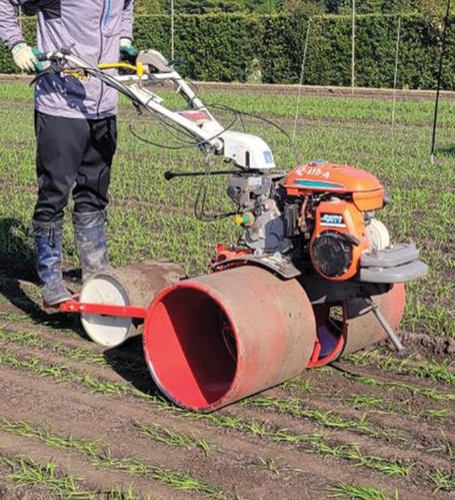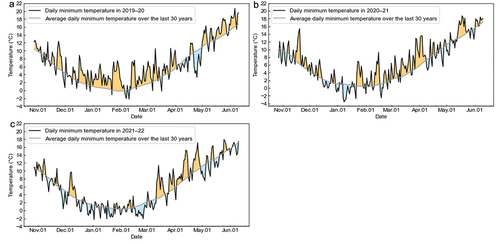ABSTRACT
Ground rolling delays spikelet initiation and thus would be expected to reduce frost injury in early-sown spring wheat. To characterize the relationship between the timing of rolling and the delay of spikelet initiation, we investigated apical development of early-sown spring wheat plants (Triticum aestivum L. cv. ‘Ayahikari’) rolled at the 1-, 2-, 3-, or 4-leaf stage in three years. All rollings delayed apical development. The delay was largest in plants treated at the 1- or 2-leaf stage: spikelet initiation by 5.0 days, the start of internode elongation by 5.5 days, and jointing by 3.5 days relative to the control. Our results and recent meteorological data suggest that in early cropping of spring wheat in the Tokai region of Japan, the earliest sowing date to avoid frost injury can be advanced by 3 days by rolling.
GRAPHICAL ABSTRACT

Introduction
In the Tokai region of Japan, paddy crop rotation management is becoming increasingly large scale, and the ratio of arable land on large-scale farms (>5 ha) to total arable land increased from 34% to 58% in the 20 years since 1995 (MAFF, Citation2018). Such an increase in planted area has made it difficult to complete wheat sowing by mid November, the optimum time; if sowing is delayed to late November, the temperature after sowing drops significantly, delaying germination, shortening the growing period, and delaying maturity, resulting in lower yields and quality (Sekiguchi et al., Citation2013). However, when sowing is advanced to before early November, the temperature during the germination and establishment period is higher, resulting in a high germination rate and vigorous initial growth, which can be expected to increase yields. Therefore, it is desirable to sow earlier in order to expand the sowing period. However, early sowing also has its problems: overgrowth can lead to lodging, resulting in reduced yields; and for spring wheat with small cold requirements, early sowing and warm winters advance the panicle formation stage and cause early internode elongation, increasing the risk of frost injury in early spring (Fujita, Citation1997; Inamura et al., Citation1958). In recent years, warm winters have become common, and the establishment of planting methods that suppress early growth is required to achieve stable and high yields in early-sown spring wheat.
We grew ‘Ayahikari’ spring wheat, which is promoted by Mie Prefecture. When sowing in mid November (standard timing), in the northern Kanto region (NARO, Citation2023) it joints in mid March, but in the slightly warmer Mie Prefecture it joints in late February to early March. Sowing earlier than mid November places the early growth period in higher temperatures, and Ayahikari, which has a small cold requirement, will joint earlier than in standard sowing, increasing the risk of frost injury due to the lifting of meristem and its exposure to low temperatures above ground. The number of grains per spikelet in wheat decreases rapidly at plant community temperatures below −4°C (Barlow et al., Citation2015), which are 2–4°C lower than those measured in a Stevenson screen. Thus, to reduce the risk of frost injury, jointing should be delayed to reduce the number of days below −2°C in a Stevenson screen.
We recently reported that early rolling before spikelet initiation is highly effective in avoiding frost injury and showed that it may be effective for suppressing early growth in spring wheat cultivars (Mizumoto et al., Citation2022). However, the optimal timing and the degree of its effect in delaying spikelet initiation have not been examined. Ground rolling has also been reported to increase tiller numbers (Arai, Citation1984; Ohtani, Citation1950). An increase in the number of productive tillers due to rolling can be expected to increase yield, especially in cultivars with low yields due to not enough stems. However, it is unclear whether rolling before spikelet initiation increases tiller numbers, because it is earlier than in conventional rolling. Moreover, early rolling exerts strong physical stress on small plants, possibly leading to disruption of later tiller development. If so, early rolling is impractical even if it results in delayed apical development.
Here, to reveal the effects of the timing and degree of rolling on spikelet initiation and stem number in early-sown spring wheat cultivars, we rolled early-sown Ayahikari at each of the 1- to 4-leaf stages and investigated apical development and tillering.
Materials and methods
Plant materials and cultivation methods
Field experiments were conducted three times from 2019 to 2022 in the experimental upland field of the NARO Institute of Vegetable and Floriculture Science, Tsu, Japan (34°46′N, 136°26′E, non-allophanic Andisols; preceding crop was sorghum), using ‘Ayahikari’, a spring wheat (Triticum aestivum) cultivar with winter growth habit Class I – II. Seeds were sown 2 weeks earlier than standard in each trial, on 1 November 2019, 2 November 2020, and 29 October 2021. With a shallow-tillage drill-seeder, seeds were sown in nine broad beds (2.1 m × 85 m) at up to 200 seeds m−2 in rows 0.24 m apart at a depth of about 2 cm (Watanabe et al., Citation2009). One bed was used for each treatment. The rolling beds were rolled with a small tractor with two rollers measuring 45 cm diameter × 48 cm wide, total 114 kg, and a stand-on roller measuring 32 cm diameter × 40 cm wide, total 79 kg (). In 2019–20, plants were rolled once at the 1-, 2-, 3-, or 4-leaf stage (GS11 to GS14 of Zadoks et al., Citation1974). In 2020–21, plants were rolled once at the 1-, 2-, 3-, or 4-leaf stage (single rolling), twice at the 1- and 2-leaf stages (double rolling), ord thrice at the 1-, 2-, and 3-leaf stages (triple rolling). In 2021–22, plants were rolled once each at the 1- or 2-leaf stage (). Fertilizer was supplied at 2.0 g N m−2, 0.87 g P m−2, and 1.66 g K m−2 at sowing as a basal dressing, and at 6.0 g N m−2 at the 4-leaf stage as topdressing. Weeds were controlled with the standard agrochemicals used in the region.
Table 1. Dates of sowing, spikelet initiation, internode, elongation and jointing.
Evaluation of developmental and agronomic characteristics and statistical analysis
Three plots of 2.15 m × 10 m were allocated to each treatment. Ten plants per plot were dug out weekly during winter (December to February). We determined the apical development stage, spike length, and stem length of their main tillers under a stereomicroscope. Apical development stage was determined as in our previous report (Mizumoto et al., Citation2022). Jointing was set at stage 8.5 (Mizumoto et al., Citation2022). We examined the tillers of 20 plants in each of the 1-leaf-stage rolling and control plots on 19 January 2021. The total number of leaves was examined for 60 plants around stage 7 in each plot and averaged. Tiller numbering was determined according to Katayama (Citation1951). The accumulated daily mean temperature was calculated as thermal time (°C·d) above a base temperature of 0°C from the sowing date. A general linear model and Tukey’s test were used to test for differences between regression lines.
Meteorological data
Weather data used to estimate the cumulative daily mean temperature for the regression analysis and the early sowing limit by the model were extracted from Agro-Meteorological Grid Square Data (Ohno et al., Citation2016) at the field’s latitude and longitude.
Results
Daily minimum temperature
The 2019–20 season had a record-breaking warm winter, with high temperatures from December to March, especially in January (3.0°C above average; ). In 2020–21, December to January was colder than normal, but temperatures were warmer from February onward. In 2021–22, November was slightly warmer than average, December until the first half of March was near normal, and temperatures were higher from the second half of March. Temperatures fell below −2°C twice in 2019–20, on 7 and 10 February; six times in 2020–21 on 7–10 and 21 January and 18 February; and three times in 2021–22, on 2 and 16 January and 25 February.
Most effective timing of rolling for delayed spikelet initiation
In all three years, rolling delayed apical development (). Single regression analyses of the relationship between apical development stage and accumulated daily mean temperature showed a strong positive correlation in all rolling treatments in all years (). This indicates that apical development depends on thermal time, as previously reported (Mizumoto et al., Citation2022). In the regression equations in , a larger slope indicates a faster development rate after spikelet initiation, and a larger intercept indicates an earlier start of spikelet initiation. In all years, the absence of any significant difference in the regression coefficients (slopes) of any of the treatments from the control (data not shown) shows that the rolling did not affect the apical development rate after spikelet initiation.
Figure 3. (a – c) effects of rolling on apical development and (d – f) relationship between accumulated daily mean temperature and apical development stage.
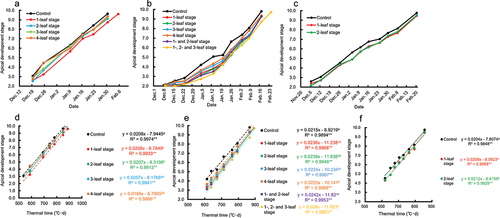
On the other hand, regression constants (intercepts) were significantly reduced relative to the control in plots with rolling at the 1- or 2-leaf stage in all years (). Intercepts were not reduced in plots with rolling at the 3- or 4-leaf stage in 2019–20, but were significantly reduced in 2020–21 (), although by significantly less than those at the 1- or 2-leaf stage. Therefore, 1- or 2-leaf-stage rolling may delay spikelet initiation more than 3- or 4-leaf-stage rolling. In addition, in 2020–21, double rolling at the 1- and 2-leaf stages and triple rolling at the 1-, 2-, and 3-leaf stages resulted in a (non-significantly) greater reduction in the intercept than single rolling at the 2-leaf stage ().
Effect of rolling on apical development
Assuming that spikelet initiation begins at apical development stage 3.0, internode elongation at stage 7.0, and jointing at stage 8.5 (Mizumoto et al., Citation2022), we determined these onset dates from the linear regression equations in (). Spikelet initiation began from mid December to early January (). Since sowing was earliest in 2021–22, the spikelet initiation stage was also the earliest. Internode elongation began from mid January to early February; it began earlier in 2019–20 owing to warmer temperatures in December and January (). This trend was also seen in the jointing stage, beginning in early to mid February in 2020–21 and 2021–22 but beginning >2 weeks earlier, in late January, in 2019–20, with an unusually warm winter.
In 2019–20, rolling at the 1-leaf stage delayed apical development the most, delaying spikelet initiation by 4 days, the start of internode elongation by 6 days, and jointing by 5 days (). Among the single rolling treatments in 2020–21, rolling at the 2-leaf stage had the greatest delaying effect, delaying spikelet initiation by 10 days, the start of internode elongation by 8 days, and jointing by 3 days. On the other hand, there was no significant difference in delay in apical development between the 1-leaf and 2-leaf-stage rollings in 2021–22, both of which delayed spikelet initiation by 3 days, the start of internode elongation by 4–5 days and jointing by 4 days (). Averaging the results over the three years, rolling at the 1- or 2-leaf stage delayed spikelet initiation by 5.0 ± 3.6 days (n = 6, ± standard deviation), the start of internode elongation by 5.5 ± 1.9 days and jointing by 3.5 ± 1.0 days.
The accumulated temperatures by jointing stage were 791.9°C in the control and 831.6°C in the 1-leaf-stage rolling in 2019–20; 810.1°C in the control and 843.1°C in the 2-leaf stage rolling in 2020–21; and 799.5°C in the control and 818.7°C in the 1-leaf-stage rolling in 2021–22. Among the single rolling treatments, rolling at the 1-leaf stage in 2019–20 had the largest delay effect of 39.7°C. Among all treatments, triple rolling at the 1-, 2-, and 3-leaf stages in 2020–21 had the largest delay effect, at 41.7°C ().
Effect of rolling on leaf number and tiller development
All rolling treatments in all years significantly increased the total number of leaves on the main stem (). In particular, rolling at the 1- or 2-leaf stage was highly effective. Multiple rollings in 2020–21 did not further increase the number.
Figure 4. Effect of rolling on the total number of leaves on the main stem.

In the 1-leaf-stage rolling treatment in 2020–21, we examined leaf number and tiller development in more detail (; survey dates differ from those in ). Rolling at the 1-leaf stage significantly increased the total number of stems per plant and numbers of unfolded leaves and total leaves on the main stem, and significantly delayed apical development; it significantly increased the numbers of plants with secondary tillers (T11 and T12) in the first and second leaf axils of primary tiller 1; with secondary tillers (T2p and T21) in the prophyll and first leaf axils of primary tiller 2; with secondary tillers (T3P) in the prophyll axil of primary tiller 3; and with primary tillers (T4) in the fourth leaf axil of the main stem.
Table 2. Effect of rolling on number of stems, number of leaves, and apical development in 2020–21.
Table 3. Effect of rolling on tillers emergence.
Discussion
Early rolling was highly effective in delaying spikelet initiation
Our previous study showed that double rolling at the 3- and 5-leaf stages or double rolling at the 2- and 3-leaf stages delayed apical development (Mizumoto et al., Citation2022). Here, to determine the optimal timing of the most effective rolling, we investigated the effects of single rolling at the 1-, 2-, 3-, or 4-leaf stage, double rolling at the 1- and 2-leaf stages, and triple rolling at the 1-, 2-, and 3-leaf stages. Rolling at either the 1- or 2-leaf stage significantly delayed spikelet initiation, with a greater effect than rolling at the 3- or 4-leaf stage (, ). Therefore, in the field, it would be better to roll between the 1- and 2-leaf stages according to the local weather and field conditions. The difference in accumulated temperatures until the jointing stage between the control and 1- or 2-leaf-stage rolling treatments ranged from 15.6 to 39.7°C, depending on the year (). The larger the difference, the more effective rolling is in delaying jointing and avoiding frost injury, so this value is a useful indicator to assess the best conditions for effective rolling. In 2020–21, triple rolling at the 1-, 2- and 3-leaf stages delayed spikelet initiation more than single rolling at the 2-leaf stage, with a higher accumulated temperature of 8.7°C by the jointing stage, but the difference in the date of jointing was minor and not significant. As triple rolling increases labor costs, a single rolling at the 1- to 2-leaf stage is sufficient in the field.
Estimation of early sowing limit to avoid frost injury
The accumulated temperatures from sowing to jointing averaged over the three years of data were 800.5°C in the control and 829.2°C in 1-leaf rolling (). Using the difference between these values (28.7°C) and the wheat development model of Nakazono et al. (Citation2014), we estimated the early sowing limit. This model uses information such as temperature and day length to estimate each growth stage of wheat. Because of the recent trend of warming winters, the temperature trend during the early growth period of wheat has differed from that of the past 30 years, so we calculated the early sowing limit for the last 10 years (2012–2021) with a view to a better fit to future conditions. First, we estimated the jointing and heading dates for sowing from 20 October to 15 November during 2012 to 2021. We assumed that the apical development of plants rolled at the 1-leaf stage is stagnant until the accumulated temperature since rolling reaches 28.7°C. The number of days with a daily minimum temperature below −2°C during 2012–2021 was calculated and averaged. We plotted the 7-day centered moving averages of the number of days experiencing a daily minimum temperature below −2°C after jointing during 2012–2021: if the sowing date without frost injury risk is defined as the early sowing limit, the limit is 15 November without rolling and 12 November with rolling ().
Figure 5. Relationship between sowing date and number of days at risk of frost injury.
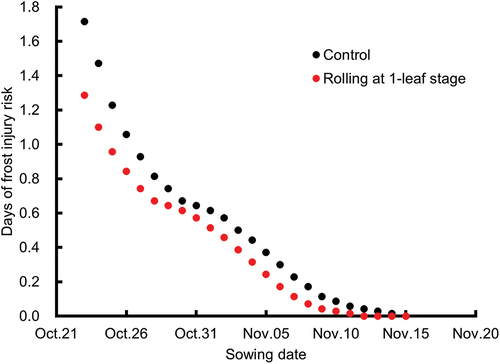
In the last 10 years, low temperatures below −2°C, which are considered high risk for frost injury, occurred frequently from January to February or sometimes March (). 2019–20, when wheat reached the jointing stage in late January, had a higher frost injury risk than the other two years. In fact, 2019–20 had the highest number of days below −2°C after jointing. We used the wheat development model to estimate the early sowing limit for avoiding frost injury, and found that early sowing can be advanced by 3 days by rolling at the 1-leaf stage (). On the other hand, frost injury risk is not limited to the jointing stage, and sterility occurs when spikes are exposed to temperatures below −1°C for several hours 8–10 days before heading (Shroyer et al., Citation1995; Takeda, Citation1976). Earlier jointing will result in earlier heading, so jointing too early, such as in 2019–20, will result in a prolonged period of higher risk. In spring wheat production in years when a warm winter is forecast, we recommend that the sowing date not be moved too early and that wheat rolling from the young seedling stage be used to control growth.
Figure 6. Frequency distribution of minimum temperatures in Tsu city, Mie Prefecture, over the last 10 years (2012–22).
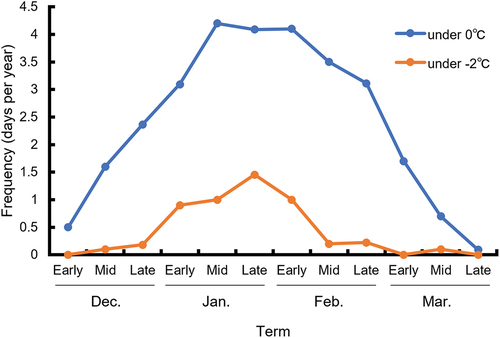
Mechanism of increase in tillers by ground rolling
Rolling increased the total number of leaves (). This may be the result of delaying the transition to reproductive phase and prolonging the vegetative phase. It also increased the number of unfolded leaves, as Ohtani (Citation1950) reported. By Katayama’s synchronous tiller development theory (Katayama, Citation1951), increasing the number of unfolded leaves increases the number of tillers. Here, rolling increased the number of unfolded leaves, and increased the number of stems by 2.5, mainly by increasing the numbers of plants with secondary tillers (T21) in the first leaf axil of primary tiller 2, secondary tillers (T3p) in the prophyll axil of primary tiller 3 and with primary tillers (T4) in the fourth axil of the main stem (). This suggests that the increase in the number of stems by rolling at the 1-leaf stage can be attributed to an increase in the number of unfolded leaves. Ohtani (Citation1950) reported that rolling increased stem number and yield. On the other hand, in spring-sown wheat in a temperate region, the effective rate of secondary tillers was low (Chujo et al., Citation1989). Whether or not rolling can increase yield may depend on whether secondary tillers are productive or not. Fukushima et al. (Citation2001) suggested that tillers having three or more unfolded leaves during the terminal spikelet initiation period (about the same time as the internode elongation stage) become productive in spring-sown wheat in temperate regions. Early rolling delays internode elongation (), which may increase the proportion of secondary tillers that have three or more unfolded leaves at this time, thereby increasing the number of productive stems. If so, it is reasonable to assume that rolling at the optimal time would increase yield.
How ground rolling delays spikelet initiation
It is possible that rolling suppresses the expression of genes related to spikelet initiation. Rolling at the 4-leaf stage had little effect on delaying spikelet initiation (), and we previously showed that rolling at the 5-leaf stage had no effect on subsequent apical development rate (Mizumoto et al., Citation2022). Together, these results show that the spikelet initiation stage (Stage 3) of the control Ayahikari was at the 4-leaf stage (). Therefore, it seems likely that gene expression causing the transition to reproductive growth had already occurred by the 4-leaf stage, explaining why rolling after this stage did not delay spikelet initiation. It is possible that rolling at the 1- and 2-leaf stage delays the expression of these genes, resulting in delayed spikelet initiation. This is currently under investigation.
Acknowledgments
We thank Hiroshi Saito, Katsuyuki Yamauchi, Yukio Araki, Yuya Wazaki (National Institute of Vegetable and Floriculture Science, NARO), Miki Arakaki, Kenji Nakabayashi, and Haruyasu Oshima (Central Region Agricultural Research Center: CARC, NARO) for their technical assistance. We express our sincere thanks to Satoshi Yoshinaga (CARC) for his critical reading of this manuscript. We are grateful to the Iwaki Farmer Group for the use of the field, to the Tokai Regional Agricultural Administration Office for planted area data, and to the Japan Meteorological Agency for temperature data.
Disclosure statement
No potential conflict of interest was reported by the author(s).
Additional information
Funding
References
- Arai, F. 1984. Ground rolling of wheat Chairman Shigeyoshi Kajiwara, Compendium of agricultural technology, crops (1st ed., Vol. 4, pp. 97–98). in Japanese Ruaral Culture Association Japan: https://lib.ruralnet.or.jp/cgi-bin/ruraldetail2.php?DSP=taikei!s!s040!s0401030.htm.
- Barlow, K. M., Christy, B. P., O’Leary, G. J., Riffkin, P. A., & Nuttall, J. G. (2015). Simulating the impact of extreme heat and frost events on wheat crop production: A review. In Field crops research (Vol. 171, pp. 109–119). Elsevier. https://doi.org/10.1016/j.fcr.2014.11.010
- Chujo, H., Benitani, H., & Mimoto, H. (1989). Appearance and heading of tillers in early wheat cultivars of west Japan. Nihon Sakumotsu Gakkai kiji, 58(4), 611–616.
- Fujita, M. (1997). Studies on breeding of early maturing wheat cultivars with tiller frost avoidance. Bulletin of the Kyushu Agricultural Experiment Station, 32, 1–50. https://agriknowledge.affrc.go.jp/RN/2010851466
- Fukushima, A., Kusuda, O., & Furuhata, M. (2001). Tiller development of winter type wheat Iwainodaichi sown early in the Southwestern Part of Japan. Nihon Sakumotsu Gakkai Kiji, 70(2), 173–178. https://doi.org/10.1626/jcs.70.173
- Inamura, H., Yamaga, I., Suzuki, K., & Gokan, M. (1958). Study on the breeding of early varieties of wheat and barley. (I.) Varietal differences of the early wheat and barley in the internode-elongation in relation to the death of young ear by frost damage in early spring. Bulletin of the Kanto–Tosan Agricultural Experiment Station, 11. in Japanese with English summary), 20–28. https://iss.ndl.go.jp/books/R000000004-I9850106-00
- Katayama, T. (1951). Studies on tillering of rice, wheat, and barley (pp. 1–117). (in japanese). https://iss.ndl.go.jp/books/R100000039-I000747235-00
- MAFF. (2018). Changes in Japan’s Agricultural structure and characteristics of the three tokai prefectures as seen in statistics. Tokai Agricultural Administration Bureau. Retrieved February 20, 2023, from https://www.maff.go.jp/tokai/kikaku/renkei/attach/pdf/20180928-63.pdf (in Japanese).
- Mizumoto, A., Tanio, M., Watanabe, K., Nakazono, K., Uchino, A., & Azuma, T. (2022). Ground rolling delays apical development and reduces frost injury in early-sown spring wheat. Plant Production Science, 25(4), 434–439. https://doi.org/10.1080/1343943X.2022.2136097
- Nakazono, K., Ohno, H., Yoshida, H., Sasaki, K., & Nakagawa, H. (2014). Modeling phenological development in wheat. Nihon Sakumotsu Gakkai Kiji, 83(3), 249–259. in Japanese. https://doi.org/10.1626/jcs.83.249.
- NARO. (2023). Wheat cultivation manual, Ayahikari. Retrieved February 20, 2023, from https://www.naro.go.jp/laboratory/nics/cultivation_manual/wheat/070446.html (in Japanese).
- Ohno, H., Sasaki, K., Ohara, G., & Nakazono, K. (2016). Development of grid square air temperature and precipitation data compiled from observed, forecasted, and climatic normal data. Climate in Biosphere, 16, 71–79. in Japanese with English title. https://doi.org/10.2480/cib.J-16-028
- Ohtani, Y. (1950). Studies on the stamping of wheat and barley. Bulletin of the National Agricultural Experiment Station, 67(in Japanese), 1–76. https://agriknowledge.affrc.go.jp/RN/2010826214.pdf
- Sekiguchi, T., Ishii, H., Okada, Y., & Sakai, K. (2013). High quality stable production technology of wheat by non-tillage sowing. Bulletin of the Saitama Prefectural Agriculture and Forestry Research Center, 12(in Japanese), 21–31. https://agriknowledge.affrc.go.jp/RN/2010851466.pdf
- Shroyer, J. P., Mikesell, M. E., & Paulsen, G. M. (1995). Spring Freeze injury to Kansas wheat. Kansas State University. C-646. https://bookstore.ksre.ksu.edu/pubs/C646.pdf
- Takeda, M. (1976). Initiation and development of the wheat spike (Chairman Shigeyoshi Kajiwara; 1st ed.). Compendium of Agricultural Technology, Crops 4 (p. 73–74). (in japanese). Ruaral Culture Association Japan, Tokyo. https://lib.ruralnet.or.jp/cgi-bin/ruraldetail2.php?DSP=taikei!s!s040!s0400730.htm
- Watanabe, T., Fukami, K., Tanio, M., Masuda, K., Matsuo, K., & Nakanishi, Y. (2009). Broad-bed planting system with shallow tillage to prevent wet injury in crop rotation system on paddy field in Japan. Proceedings 18th ISTRO Conference T1-016, 1–5. https://www.istro.org/index.php/publications/proceedings/24-istro-2009-proceedings/file
- Zadoks, J. C., Chang, T. T., & Konzak, C. F. (1974). A decimal code for the growth stages of cereals. Weed Research, 14(6), 415–421. https://doi.org/10.1111/j.1365-3180.1974.tb01084.x
